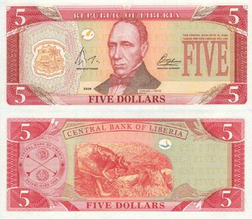Liberian dollar
| Liberian dollar | |
|---|---|

A current $5 banknote
|
|
| ISO 4217 | |
| Code | LRD |
| Denominations | |
| Subunit | |
| 1/100 | cent |
| Symbol | L$ |
| Banknotes | 5, 10, 20, 50, 100 and 500 dollars |
| Coins | 5, 10, 25, 50 cents, 1 dollar |
| Demographics | |
| User(s) |
|
| Issuance | |
| Central bank | Central Bank of Liberia |
| Website | cbl |
| Valuation | |
| Inflation | 7.7% |
| Source | The World Factbook , 2015 est. |
The dollar (currency code LRD) has been the currency of Liberia since 1943. It was also the country's currency between 1847 and 1907. It is normally abbreviated with the dollar sign $, or alternatively L$ or LD$ to distinguish it from other dollar-denominated currencies. It is divided into 100 cents.
The first Liberian dollar was issued in 1847. It was pegged to the US dollar at par and circulated alongside the US dollar until 1907, when Liberia adopted the British West African pound, which was pegged to sterling.
In 1847, copper 1 and 2 cents coins were issued and were the only Liberian coins until 1896, when a full coinage consisting of 1, 2, 10, 25 and 50 cents coins were introduced. The last issues were made in 1906.
The Treasury Department issued notes between 1857 and 1880 in denominations of 10 and 50 cents, 1, 2, 3, 5 and 10 dollars.
United States currency replaced the British West African pound in Liberia in 1935 [1]. Starting in 1937, Liberia issued its own coins which circulated alongside US currency.
The flight of suitcase-loads of USD paper in the economic collapse following the April 12, 1980 coup d'état created a currency shortage, which was only exacerbated when the government began minting $5 coins. Unfortunately the 7-sided coins were the same size and weight as the one-dollar coin; this similarity was frequently abused by traders.
In the late 1980s the coins were largely replaced with a newly designed $10 note modeled on the US greenback ("J. J. Roberts" notes). The design was modified during the 1990-2004 civil war to ostracize notes looted from the Central Bank of Liberia. This effectively created two currency zones -- the new "Liberty" notes were legal tender in government-held areas (primarily Monrovia), while the old notes were legal tender in non-government areas. Each was of course illegal in the other territory.
...
Wikipedia
